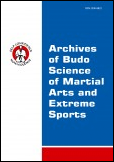2015, Volume 11, Issue 1
Usability of non-apparatus and quasi apparatus flexibility tests based on self-perception participants in health-related judo training
Dariusz Mosler1
1Faculty of Physical Education, Department of Combat Sports, Gdansk University of Physical Education and Sport, Gdansk, Poland
Author for correspondence: Dariusz Mosler; Faculty of Physical Education, Department of Combat Sports, Gdansk University of Physical Education and Sport, Gdansk, Poland; email: dariusz.mosler[at]gmail.com
Full text
Abstract
Background and Study Aim: In training practice, too little attention is paid to association between objective indicators of phenomena, which measures incentives and training effects with subjective sensations of trained persons. The aim of this study is knowledge about relationships between subjective feelings of athletes use different non-apparatus and quasi apparatus flexibility tests and objective results of this tests in three situations judo training.
Materials and Methods: Eight male subjects were examined during 3 judo recreation training sessions: age ranged from 18 to 43 years (mean 28.8 ±8.5); training experience ranged from 0.5 to 3 years (mean 1.4 year). In assessment, three flexibility tests were used each time in three different training situations, switching the order of their usage: FFD, SABS, SASRT. For evaluation of their opinion about test, they were asked to put scores ranged from 1 to 5 for five features determining: F1 – comfort of test; F2 – perception of security; F3 – compatibility with own perception of flexibility; F4 – precision of assessment; F5 – toleration of negative feelings from different parts of body.
Results: Only SASRT’s (self-assessment sit reach test) test where rated lowest ratings had significant correlations between two features and resting state of the body. Especially indicators F2 and F4 during assessment SASRT and SABS (modified measurement of finger-floor distance – self-assessment Bending scale) suggests relations between subjective discomfort sensations of training participants with real state of body stimulation and generating unwanted muscle stiffness during exercises for specific training session stage.
Conclusions: Simultaneous application of SASRT and self-perception scale are simple tools for diagnosing flexibility in different states of body stimulation and direct assumptions about generating unwanted muscle stiffness during exercises (randori) before assessment.
Key words: extreme effort, flexibility level, intensity zones, motor safety, randori





